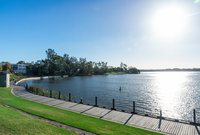Liverpool Property Market Update 2nd Half of 2021
In Q3 2021, Liverpool recorded a median house price of $970,000, and a median unit price of $530,000. This represents annual (Q3 2020 – Q3 2021) median price growth of 37.6% for houses and 1.0% for units. Between Q3 2020 – Q3 2021 total house sales decreased by -22.0% (to 571 sales) and unit sales increased by 15.4% (to 300 sales). Q3 2021 recorded the lowest amount of house sales between 2020 and 2021, indicating demand is outpacing supply. This has resulted in significant median price growth, thus now is an ideal time for house owners to transact in Liverpool.
In Q3 2021, Liverpool recorded a median house price of $970,000, and a median unit price of $530,000. This represents annual (Q3 2020 – Q3 2021) median price growth of 37.6% for houses and 1.0% for units. Between Q3 2020 – Q3 2021 total house sales decreased by -22.0% (to 571 sales) and unit sales increased by 15.4% (to 300 sales). Q3 2021 recorded the lowest amount of house sales between 2020 and 2021, indicating demand is outpacing supply. This has resulted in significant median price growth, thus now is an ideal time for house owners to transact in Liverpool.
Average vendor discounts between Q3 2020 and Q3 2021 have tightened for both property types, to -0.8% for houses and -4.7% for units. Despite a tightening over a 12-month period, the past 6 months between Q1 2021 – Q3 2021 saw vendor discounts widening slightly. Liverpool market conditions suggest that for the time being, this is as close to initial first listed prices that buyers will have to pay to enter the market.
In September 2021, house rental yields in Liverpool were recorded at 2.6%. In the 12 months to Q3 2021, the median house rental price increased by 5.8% to reach $550 per week, while average days on the market remained the same (21 days). There is a mature and resilient rental market throughout 2021 despite lockdowns and increased unit supply.
4+ bedroom houses have provided investors with +5.3% rental growth annually, with a median rent of $600 per week.
Also in September 2021, Liverpool recorded a vacancy rate of 2.7%, above that of Liverpool LGA (1.8%) but on par with Sydney Metro (2.7%). Vacancy rates in Liverpool have remained below the Real Estate Institute of Australia’s healthy benchmark of 3.0% since the beginning of 2020. This confirms there is a healthy rental demand and investors can be confident of a conducive investment environment in Liverpool.





